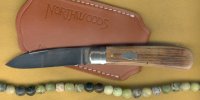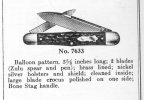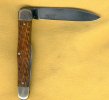waynorth
Dealer / Materials Provider
- Joined
- Nov 19, 2005
- Messages
- 33,333
All controversy aside, that's a beauty!!Meanwhile, Happy New Year to all. Here is a knife with a shackle.
The BladeForums.com 2024 Traditional Knife is available! Price is $250 ea (shipped within CONUS).
Order here: https://www.bladeforums.com/help/2024-traditional/
All controversy aside, that's a beauty!!Meanwhile, Happy New Year to all. Here is a knife with a shackle.



So my swayback knife is more accurately termed as a wharncliffe knife? Huh, who knew? I think I'll just avoid the confusion altogether and start calling it a corbo.
Rachel is right (of courseA Wharncliffe knife is closer to what Case calls a Seahorse Whittler.
I think.


Thanks Gary, I really feel for you and Frank my friendWell said, Jack! Oh, and I wish I had the luxury of using the ignore function!


I think that probably is just a coincidence Tom, but it's a GOOD one!

I'm sure Case knew the correct name for that patternI was going to say that the shape of the frame of the Wharncliffe Knife pattern reminds me of a "serpentine sleeveboard with rounded bolsters", but I like Rachel's analogy to a Case Seahorse whittler better.


Well saidI am about as anal as anyone regarding these terms, but I don't mind some ignorance, I guess. Stupidity is another manner. LOL.

I think you're right there my friend, Happy New YearNow, then: the bails. Bails are on pails. Milk pails, lard buckets, etc. And, as a verb, to get water out of your boat before it sinks. On knives, from time immemorial they were called shackles, just as in larger applications, such as in sailing ship gear and construction work with steel cable. I like the sound of shackle, and I use that term because it makes me feel clever. Bale! I see that one. That is how they put up cotton, hay and straw, and, back in the day, bison hides. That end-piece on the butt of a fixed blade knife is usually called a pommel, but I get a chuckle when I see 'pummel.' I think that used to be a verb indicating a certain amount of boxing about the ears, and such. Meanwhile, Happy New Year to all. Here is a knife with a shackle.View attachment 1712982

Rachel is right (of course), a Wharncliffe Knife has a particular serpentine frame, a single spring, a main blade with a straight edge and spine that slopes evenly back from the point, and a secondary Pen blade. That's a Wharncliffe Knife



What year please??
Happy New Year, Christian!!!

A very helpful explanation — much appreciated!Rachel is right (of course), a Wharncliffe Knife has a particular serpentine frame, a single spring, a main blade with a straight edge and spine that slopes evenly back from the point, and a secondary Pen blade. That's a Wharncliffe Knife


Or a half fast whittler. S/he not a fast whistler, nor a slow one.Much worse is "half-whit . . . . .ler"
"EDC" wasn't a big term before the Internet and blade forums.I'm pretty sure the term EDC wasn't a big term before YouTube.

Seems there are a lot of Boys without Boy's names these days!!It reminds me of the boy named Sue. It's not a boy's name, but is still his name, and therefore correct!




I think I recall that Case's Tony Bose Inspired Tribal Spear, was called a Zulu Spear by Tony. Case decided it was a problem using that name because of the African Zulu tribe.Seems there are a lot of Boys without Boy's names these days!!
Humor aside, I like the name "Zulu Spear"! I don't know if certain Africans resent cultural appropriation, but that name doesn't strike me as demeaning, when it describes and names a subset of blades!
View attachment 1714579View attachment 1714581View attachment 1714582View attachment 1714583
OK, seems I miss remembered this. I found this post. It's likely more accurate.I think I recall that Case's Tony Bose Inspired Tribal Spear, was called a Zulu Spear by Tony. Case decided it was a problem using that name because of the African Zulu tribe.
Of course, as shown in post #76 above, Schrade used the name in their catalog in the 1920s - I wonder if that constitutes a copyright?? Moot now, perhaps??"Zulu Spear"
Maybe that's what Kerry was referring to?Of course, as shown in post #76 above, Schrade used the name in their catalog in the 1920s - I wonder if that constitutes a copyright?? Moot now, perhaps??
